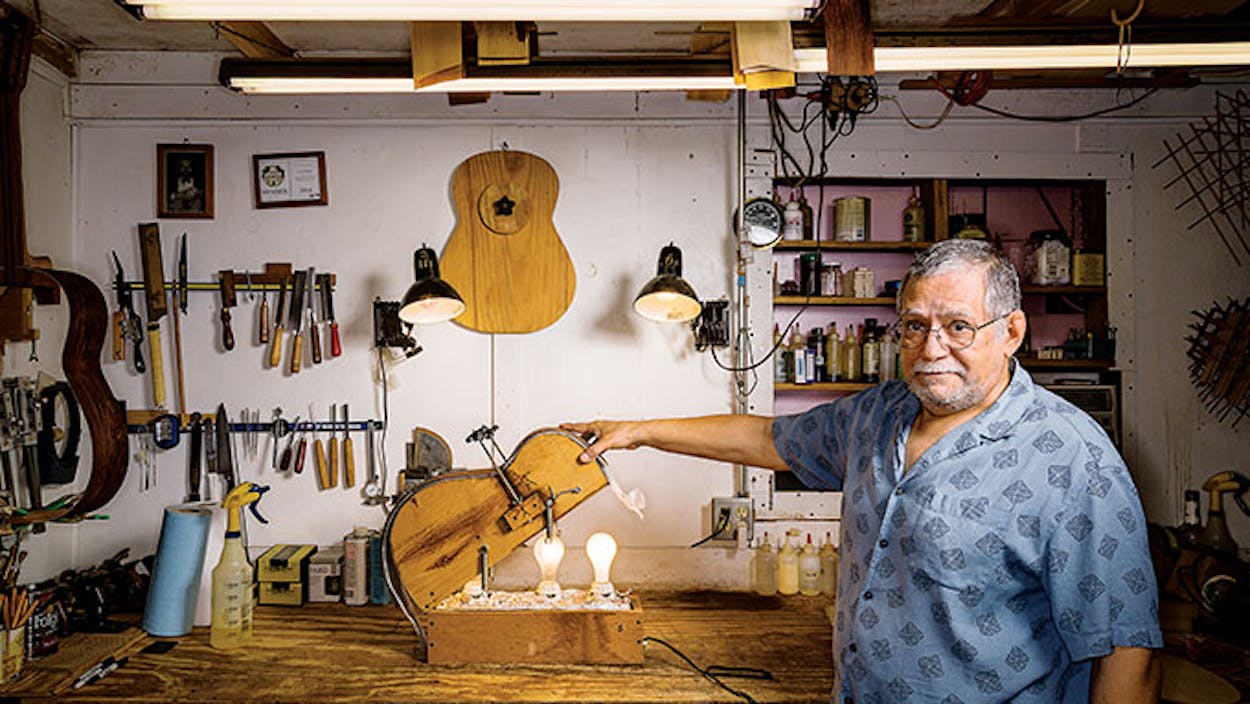Lucio Núñez has been making guitars for almost 35 years, but in some ways he is still the philosophy teacher that he was in Mexico City back in the seventies. “Lutherie depends on both science and mystery. The space between one note and another, the way we work with sound frequencies—that is physics. But the way music touches our souls—that is a mystery.” Music and art were heavily prized in Núñez’s family: his mother owned a record store, and his brother became an architect. Núñez chose to pursue academia, but by the age of 33 he’d grown frustrated. Seeking a distraction, he decided to build a guitar, using tools his brother had on hand. He refinished that first guitar seven times. “I don’t know what possessed me, but I wanted to do it until I got it right,” he says. Since then, Núñez (who moved to San Antonio in 1998) has made more than 1,500 classical and flamenco guitars, though he insists he has yet to master his craft.
“I don’t see myself doing anything but making guitars, because I still want to learn how to make them,” he says. “There is a lot of stuff we don’t know about art, and that’s what makes it so interesting.”

Q&A with Lucio Núñez
Do you play guitar?
Only a few chords, to make adjustments on a design. It is so time-consuming to build guitars that it’s rare to find someone who makes and plays guitars. Guitarmakers tend to be humble, because all you are doing is making a tool—someone else will create the art with it.
What drew you to guitarmaking?
I always admired them as beautiful objects. Instruments like the piano and violin are considered close to perfect, but the guitar is still evolving and doesn’t yet have the respect of some of the others. Also, the voice is soft—I could listen to classical guitars all day long, but I don’t think I could listen to drum solos that much.
Did you feel like you’d found your calling after you made your first guitar?
When I was young, I was crazy. Because of my education in philosophy, I had the idea that there had to be an objective way to produce a really good guitar, but I soon discovered there isn’t such a thing. I experimented a lot. It’s not difficult to make a decent-sounding guitar, but to make one that is really, really good—I still don’t know what it takes.
What is your approach to building a guitar?
I use only wood—no carbon fiber, space-age materials, or glues. The sides of my guitars are laminated for both structural and acoustic purposes. The top of the guitar is the most important part of the instrument. A thinner top vibrates more efficiently due to its flexibility. I use a lattice bracing system on most of my guitars, which is a net of fine struts that makes the top strong enough to resist the tension of the strings.
Is there one guitar in particular that you’re most proud of?
I have been pleased with different aspects of each of them, maybe one because it was powerful or one because of its voice. Each has its own particular voice. It’s a mysterious process, in a way. You can work, work, work, and you play the first chord and you get disappointed.
Do you ever feel a twinge of sadness when one leaves your studio to go to a customer?
Sometimes, yes. But I console myself by thinking that I will make another one similar to it.
Have you had any apprentices?
People get interested, but not many stick with it. I can only think of one who’s still making guitars, Jun Nakano. He’s from Japan, and he is still making them over there.
How did you meet him?
He was in Mexico from 1988 to 1990 studying sociology. He is a fantastic guitarmaker.
For more information, go to lucionunezguitars.com.







